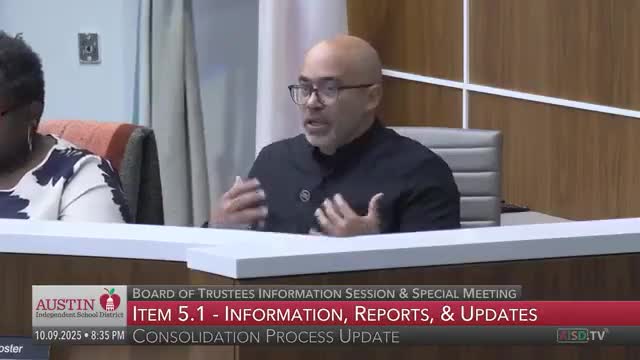AISD reports gains in third‑grade math; trustees accept monitoring report
October 11, 2025 | AUSTIN ISD, School Districts, Texas
This article was created by AI summarizing key points discussed. AI makes mistakes, so for full details and context, please refer to the video of the full meeting. Please report any errors so we can fix them. Report an error »

The Austin Independent School District board accepted, without objection, a monitoring report Oct. 9 showing preliminary gains in third‑grade mathematics. The report shows the percentage of third graders scoring “meets grade level or above” on the STAR math assessment increased from 39% in 2024 to 42% in 2025.
Why it matters: District leaders presented the increase as early evidence that recent investments in curriculum, teacher retention and coaching are improving early numeracy. The board framed the acceptance as an acknowledgement of progress while emphasizing continued work is necessary to close gaps for historically underserved student groups.
What the report said: Assistant Superintendent Dr. Christine Maxwell and her team described five priorities underpinning the gains: building a trust‑based culture for instruction, retaining and supporting effective teachers, distributing high‑quality, aligned instructional materials, strengthening instructional coaching and expanding the district’s multitiered systems of support (MTSS). Key points from the presentation:
- District outcome: The percent of third graders scoring meets or above on STAR Math rose to 42% in 2025, exceeding the administration’s target for the year.
- Goal progress measure: The district uses second‑grade MAP mathematics percentiles to forecast third‑grade outcomes. Staff reported those progress measures correlated with the summative STAR results this year.
- Equity gaps: The administration highlighted persistent gaps by student group. For example, Asian and white student groups exceed 60% meets/above, while Hispanic and African American groups remain significantly lower. The district said targeted supports at high‑need campuses will be prioritized.
- District actions: Schools implementing district‑adopted math materials with high fidelity and those with strong leadership coaching (so‑called Lighthouse schools) showed notable gains. The administration urged continuing professional learning, observation and feedback cycles, and a Lighthouse/learning‑lab model that pairs high‑performing campuses with cohorts of nearby schools.
Trustee remarks and vote: Trustees asked for more campus‑level detail and for explicit plans about how to replicate Lighthouse coaching across the district. After discussion the board voted unanimously to accept the monitoring report.
Ending: District staff said they will continue to prioritize math professional learning, strengthen leadership coaching and focus resources on high‑need campuses so the early gains can be sustained and extended across student groups.
Why it matters: District leaders presented the increase as early evidence that recent investments in curriculum, teacher retention and coaching are improving early numeracy. The board framed the acceptance as an acknowledgement of progress while emphasizing continued work is necessary to close gaps for historically underserved student groups.
What the report said: Assistant Superintendent Dr. Christine Maxwell and her team described five priorities underpinning the gains: building a trust‑based culture for instruction, retaining and supporting effective teachers, distributing high‑quality, aligned instructional materials, strengthening instructional coaching and expanding the district’s multitiered systems of support (MTSS). Key points from the presentation:
- District outcome: The percent of third graders scoring meets or above on STAR Math rose to 42% in 2025, exceeding the administration’s target for the year.
- Goal progress measure: The district uses second‑grade MAP mathematics percentiles to forecast third‑grade outcomes. Staff reported those progress measures correlated with the summative STAR results this year.
- Equity gaps: The administration highlighted persistent gaps by student group. For example, Asian and white student groups exceed 60% meets/above, while Hispanic and African American groups remain significantly lower. The district said targeted supports at high‑need campuses will be prioritized.
- District actions: Schools implementing district‑adopted math materials with high fidelity and those with strong leadership coaching (so‑called Lighthouse schools) showed notable gains. The administration urged continuing professional learning, observation and feedback cycles, and a Lighthouse/learning‑lab model that pairs high‑performing campuses with cohorts of nearby schools.
Trustee remarks and vote: Trustees asked for more campus‑level detail and for explicit plans about how to replicate Lighthouse coaching across the district. After discussion the board voted unanimously to accept the monitoring report.
Ending: District staff said they will continue to prioritize math professional learning, strengthen leadership coaching and focus resources on high‑need campuses so the early gains can be sustained and extended across student groups.
View full meeting
This article is based on a recent meeting—watch the full video and explore the complete transcript for deeper insights into the discussion.
View full meeting
